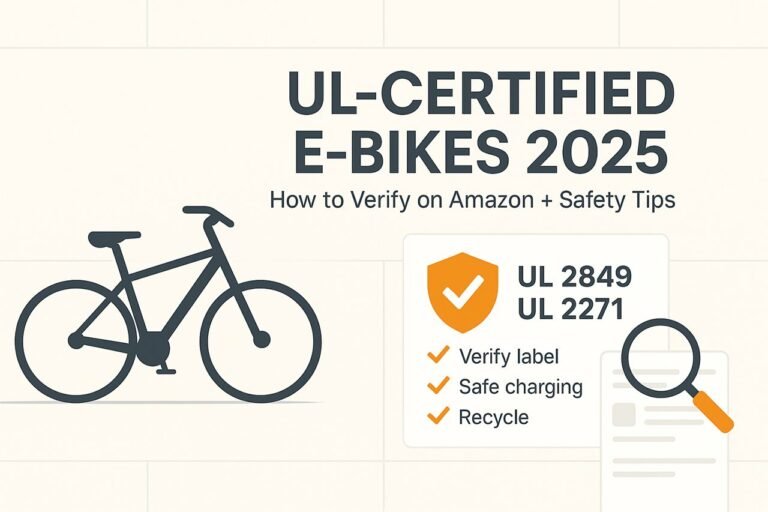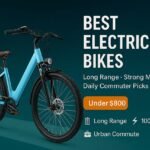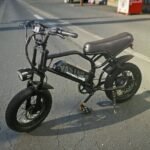
Hey there, friend! So, you’re thinking about getting an electric bike? Awesome choice—e-bikes are a blast, eco-friendly, and a great way to zip around town or hit the trails without breaking a sweat (unless you want to!). Whether you’re curious about how to choose an electric bike or just want to make sure you pick the perfect ride, I’ve got your back with a straightforward guide to finding the one that’s right for you.
Here’s the quick rundown of how to choose the right electric bike in five simple steps:
- Figure out your riding style and needs.
- Set a realistic budget.
- Pick the right motor and battery.
- Test ride and compare models.
- Check for extra features and support.
In this article, I’ll break down each of these steps with all the details you need to confidently choose an e-bike that fits your lifestyle. We’ll cover everything from the types of e-bikes to motors, batteries, and even some handy tips to avoid buyer’s remorse. Let’s dive in and get you rolling!
What You’re Going to Need
To choose a electric bike that’s perfect for you, here’s what you’ll need:
- A clear idea of your riding goals: Are you commuting, cruising for fun, or tackling off-road trails?
- A budget range: E-bikes can cost anywhere from $500 to $5,000+, so know what you’re comfortable spending.
- Access to a bike shop or test-ride events: Trying before buying is key!
- Basic research tools: A smartphone or computer to check reviews, specs, and local dealers.
- A notebook or app: Jot down models, features, and prices to compare options.
- Optional gear: A helmet and comfortable shoes for test rides (safety first!).
Video Tutorial
If you’re a visual learner, this YouTube video from Electric Bike Report is a fantastic starting point. It walks through the key factors in choosing an e-bike, aligning closely with the steps we’ll cover here:
Step 1: Figure Out Your Riding Style and Needs
Alright, let’s start with the fun part: dreaming about where you’ll ride your e-bike! The first step in how to choose an electric bike is nailing down what you’ll use it for. Are you zipping to work through city streets? Cruising along beach boardwalks? Or maybe shredding some mountain trails? Each riding style points to a different type of e-bike, so let’s break it down.
E-bikes come in a few main flavors:
- Commuter e-bikes: Sleek, with upright geometry for city riding. Think pavement, bike lanes, and maybe a basket for your coffee tumbler.
- Mountain e-bikes: Beefy tires, suspension, and rugged frames for off-road adventures. Perfect for trails and dirt paths.
- Cruiser e-bikes: Laid-back vibes with comfy seats for leisurely rides on flat terrain, like beachside paths.
- Folding e-bikes: Compact and portable, great for small apartments or mixing with public transit.
- Cargo e-bikes: Built to haul groceries, kids, or gear, with sturdy frames and sometimes extra battery power.
Ask yourself: Where will I ride most? How far? Will I need to carry stuff or climb steep hills? For example, if you’re commuting 10 miles each way in a hilly city like San Francisco, a commuter e-bike with a strong motor and decent battery range is your best bet. If you’re just cruising around a flat neighborhood, a simpler cruiser might do the trick.
Tips:
- Jot down your typical routes and terrain (urban, rural, hilly, flat).
- Consider storage: Do you have space for a full-size bike, or do you need a folding model?
- Think about speed: If you want to go faster than 20 mph, check local laws, as some e-bikes are capped at different speeds.
Step 2: Set a Realistic Budget
Now, let’s talk money—don’t worry, I’ll keep it real! E-bikes range wildly in price, from budget-friendly models around $500 to high-end ones topping $5,000. To choose the right electric bike, you need to know what you’re willing to spend and what you’re getting for your bucks.
Here’s a rough breakdown of price ranges:
- $500–$1,000: Entry-level e-bikes, often with basic motors and batteries. Great for casual riders but may lack durability or range.
- $1,000–$2,000: Mid-range options with better components, like stronger motors and longer-lasting batteries. Ideal for commuters or frequent riders.
- $2,000–$5,000+: Premium e-bikes with top-tier features, like advanced suspension, high-capacity batteries, or lightweight frames. Perfect for enthusiasts or heavy-duty use.
Your budget will shape your options, but don’t just chase the cheapest deal. A $600 e-bike might seem tempting, but if the battery dies after 10 miles or the frame wobbles, you’ll regret it. Instead, think about value: a $1,500 bike with a reliable motor and good customer support might outlast a bargain-bin model. Also, factor in extras like helmets, locks, or maintenance costs—those add up!
Tips:
- Check for sales or refurbished models from reputable brands like Rad Power Bikes or Trek.
- Look into financing options; many bike shops offer payment plans.
- Don’t forget to budget for accessories like a good lock (e-bikes are theft magnets!).
Step 3: Pick the Right Motor and Battery
Here’s where things get a bit techy, but don’t worry—I’ll keep it simple. The motor and battery are the heart and soul of an e-bike, and choosing the right combo is critical to how to choose a electric bike that feels great to ride. Let’s unpack both.
Motors
E-bike motors come in two main types:
- Hub motors: Built into the wheel (usually rear, sometimes front). They’re simpler, cheaper, and great for flat terrain or casual riding. Downside? They can feel less responsive on steep hills.
- Mid-drive motors: Positioned near the pedals, these offer better balance and power for climbing or off-roading. They’re pricier but more efficient for varied terrain.
Motor power is measured in watts (W). Most e-bikes range from 250W to 750W. A 250W motor is fine for flat city rides, while 500W–750W is better for hills or heavy loads. Check your local laws—some areas limit motor power or speed (e.g., 20 mph in the U.S. for Class 1 and 2 e-bikes).
Batteries
The battery determines how far you’ll go before needing a recharge. Battery capacity is measured in watt-hours (Wh). A 400–500Wh battery might give you 20–40 miles, while a 600–800Wh one could stretch to 50–80 miles, depending on terrain, rider weight, and how much you pedal.
Look for removable batteries for easy charging and consider charge time (usually 3–6 hours). Also, check the brand—reputable ones like Bosch or Shimano tend to last longer than no-name batteries.
Tips:
- Test how the motor feels on a hill during a test ride (more on that in Step 4).
- Check the battery’s warranty—2–3 years is standard for quality brands.
- If you’re riding long distances, prioritize higher watt-hour ratings for more range.
Step 4: Test Ride and Compare Models
You wouldn’t buy a car without a test drive, right? Same goes for e-bikes! Test riding is a game-changer when figuring out how to choose an electric bike. It lets you feel the bike’s handling, comfort, and power in real-world conditions. Plus, it’s fun!
Visit local bike shops or e-bike dealers to try different models. Many brands, like Specialized or Aventon, host demo days or have showrooms. If you’re eyeing online-only brands like Lectric or Rad Power, check if they have pop-up events or return policies that let you test risk-free. During your test ride, focus on:
- Comfort: Does the seat feel good? Are the handlebars at a comfy height?
- Power delivery: Does the motor kick in smoothly or jerkily?
- Weight: Can you lift or maneuver the bike easily? E-bikes are heavier than regular bikes (40–70 lbs).
- Controls: Are the display and buttons intuitive?
Compare at least 2–3 models in your budget and style range. For example, if you’re torn between a commuter and a folding e-bike, ride both to see which feels better. Take notes on each bike’s pros and cons—trust me, they blur together after a few rides!
Tips:
- Ride on terrain similar to your usual routes (e.g., hills, pavement, or gravel).
- Test the brakes—disc brakes are best for e-bikes due to their weight and speed.
- Ask about return policies or warranties in case the bike doesn’t feel right after a week.
Step 5: Check for Extra Features and Support
You’re almost there! Once you’ve narrowed down your e-bike choices, it’s time to look at the extras that can make or break your experience. A great e-bike isn’t just about the motor or frame—it’s about the little things that make riding more enjoyable and practical.
Consider these features:
- Display: A clear LCD or LED screen showing speed, battery life, and assist level is super helpful.
- Lights: Built-in front and rear lights are great for night rides or low visibility.
- Racks and fenders: Handy for carrying bags or staying mud-free in wet weather.
- Suspension: Front or full suspension smooths out bumpy rides, especially for mountain or gravel e-bikes.
- Connectivity: Some e-bikes have apps for tracking rides or tweaking settings—cool but not essential.
Also, check the brand’s reputation and support:
- Warranty: Look for at least a 1–2-year warranty on the frame and battery.
- Customer service: Read reviews to see if the company responds to issues quickly.
- Local support: If possible, buy from a brand with nearby dealers for repairs or tune-ups.
For example, brands like Trek or Specialized have solid warranties and widespread dealer networks, while online brands like Rad Power offer good support but may require shipping for repairs. Weigh these factors based on how much you’ll rely on the bike.
Tips:
- Read user reviews on sites like ElectricBikeReview.com for real-world insights.
- Ask about maintenance costs—e-bikes need occasional tune-ups like any bike.
- If buying online, confirm shipping costs and assembly requirements (some bikes arrive 90% assembled).
Final Thoughts
Congrats, you’re now armed with everything you need to choose the right electric bike! We’ve covered how to match your riding style to the perfect e-bike type, set a budget that balances cost and quality, pick a motor and battery that deliver the power and range you need, test ride to find your ideal fit, and check for those extra features that make riding a joy. By following these steps, you’ll roll away on an e-bike that feels like it was made for you.
Take your time, have fun with the process, and don’t be afraid to ask questions at bike shops or online forums. Your perfect e-bike is out there, ready to make your commutes, adventures, or leisurely rides a whole lot more exciting. Now, go hit the road (or trail) and enjoy the ride!
Frequently Asked Questions
Choosing an electric bike can be a bit tricky with all the options out there. It’s important to consider key aspects like beginner tips, important features, and different types of e-bikes, as well as understanding wattage and expert suggestions.
What should a beginner know before purchasing their first electric bike?
Beginners should focus on factors like budget, usage, and comfort. It’s wise to test-ride different models to see which one fits best. Understanding the basics like battery life, motor power, and charging time can also help make an informed decision.
What are the most important features to consider when looking for an e-bike?
Features like battery capacity, motor type, and bike weight are vital. A typical electric bike weighs about 45 to 50 pounds. The frame size should match your height to ensure comfortable rides.
Are there specific electric bike models that seasoned riders suggest avoiding?
Experienced riders might advise against overly cheap models that could compromise on quality. Some may suggest avoiding heavy bikes if you plan on frequent transportation or storage. It’s always good to read reviews and get opinions from fellow riders.
Could you break down the different types of e-bikes for me?
E-bikes come in various types like commuter, mountain, and foldable models. Each type serves a different purpose, from city streets to rugged trails. The choice depends on your daily needs and where you plan to ride most often.
How critical is wattage when comparing e-bike power and performance?
Wattage indicates motor power, affecting speed and hill-climbing prowess. Higher wattage usually means better performance but may decrease battery range. It’s crucial to balance your need for speed with the distance you want to travel per charge.
What key knowledge should I arm myself with before venturing into the world of electric bikes?
Understanding the different components like motors, batteries, and controls is key. It’s also helpful to know how often to maintain the bike for optimal performance and longevity. This can make the entry into e-bike world much smoother.



![How to Change Gears on a Bike: A Beginner’s Step-by-Step Guide [year] How to Change Gears on a Bike: A Beginner’s Step-by-Step Guide [year]](https://goebikelife.com/wp-content/uploads/2023/12/How-to-Change-Gears-on-a-Bike-for-Beginners-768x512.jpg)





